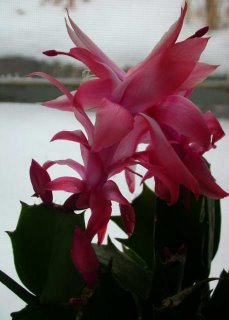 What’s blooming outside: Nothing.
What’s blooming outside: Nothing.What’s blooming inside: Aptenia, zonal geranium, Christmas cactus.
What’s green and visible in the area: Snow covers everything.
Animal sightings: Rabbit out last Sunday. Occasional small bird landed on Maximilian sunflower heads during week and leaned over to peck seeds.
Weather: Sunday melted snow from 20 December; about 3" left by Wednesday. Heavy snow fell Friday at dawn. Smaller flakes fell Saturday before dawn and continued all day; temperatures stayed warm enough that some snow melted below, while more accumulated above.
Weekly update: Holidays are so alluring with their Poinsettias and Christmas Cacti, which some are able to keep blooming year after year.
I finally succumbed. I rationalized that since it was a cactus, it should be able to survive the rugged conditions on my enclosed porch. Only when I got home did I read the label. Bay City Flower Company never actually called it a Christmas Cactus, just gave a Latin name, Schlumbergia Truncata, said it was the product of “worldwide hybridization” and left it to me to supply the associations, which of course, gullible consumer that I am, I did.
When the deep-rose-colored buds started to open, I discovered the flowers look like badly died carnations, with white centers and carmine tips. Fortunately, I normally see it from a distance, through the porch door, and the colors diffuse into an opalescent pink.
I can’t fault the grower for misrepresentation. Schlumbergia Truncata was the first of the genera to be sent to Europe in1819 from the Organ mountains north of Rio de Janeiro. Schlumbergia Russelliana followed in 1837, and, was inevitable in those days of experimentation, William Buckley introduced a cross of the two in 1852 for the Rollison Nurseries in England that became the first Christmas Cactus (Sclumbergia x Buckleyi).
From there it spread, not just through commerce, but through its own initiative. Schlumberigia has jointed stems that break easily, and root themselves in the litter that accumulates in tree branches. It quickly became a pass-along plant that moved from neighbor to neighbor, from generation to generation, as it had probably moved from tree to tree under the rainforest canopy.
Mark Zwonitzer tells us, Mollie Bays Carter’s “granddaughters, great-granddaughters, and great-great-granddaughters still have portions of a Christmas cactus she started more than a century ago, and to this day that plant blooms in houses up and down Poor Valley.”
It’s a shorter hop from Brazil to my New Mexico porch via England and Half Bay Moon, California, than from commercial greenhouses to her small Clinch Mountain hamlet in southwestern Virginia in the early twentieth century where hard cash was scarce. Mollie was 17 when she married Robert Carter to live in a log cabin with nothing covering the window opening in 1890. A few years later they moved to land given them by her father, and later still, to a house built for them by their son, Eck.
One can conjure any number of routes that plant took to arrive there. Mollie’s brother, Flanders Bays, ran singing schools and sold trees and shrubs for Larkey Nursey; later her son Pleasant joined him on the circuit. Either could have bought a plant at discount, or been given one. It’s the type of thing that might have been used as a sales prize.
One of Robert’s kin on his paternal grandmother’s side, John Smith, left for Richmond, a rail junction town in Indiana in the 1880s. Thereafter, whenever someone needed money he headed to Wayne County. Robert had gone before he married Mollie. Pleasant gave it a try in 1911. Anyone could have brought back a plant, and from there it could have spread from Bays to Bays, until it reached Mollie.
The plant may not really be 100 years old. Accurate chronology is often lost when grandchildren discuss a past before their memories. It could as easily date from some time in the 1920s when Eck was making good money working as a postal clerk on the railroad, or after Pleasant began making hillbilly records with his wife Sara and Eck’s wife Maybelle. A brilliant red flower blooming in December is just the sort of inexpensive luxury someone would buy who didn’t have a lot of money, but could afford a small indulgence.
The little plant could have followed any of the paths cash took to enter a subsistence community much like that of northern New Mexico before World War II. The important thing is that despite its commercial origins, the Christmas Cactus became a symbol of family tradition, not just among the Bays and Carters, but among families everywhere in this country who pass on cuttings.
In southwestern Virginia it became something more. Gardening may not have been indigenous there, but an appreciation of beauty was, especially for gifted voices. Mollie’s son and daughters-in-law became famous as A. P. and the Carter Family. Sara will always be remembered for putting together one of their most enduring songs from a miscellany of exotic plant images. “Wildwood Flower” is about love and beauty and music, and maybe that rare glimmer of winter color that was passed from hand to hand as precious a heritage as all the song signifies.
Notes: Zwonitzer, Mark with Charles Hirshberg, Will You Miss Me When I’m Gone? The Carter Family and Their Legacy in American Music, 2002.
Photograph: Schlumbergia Truncata, 30 December 2006, with two flowers and some buds looking through the window to fresh snow.
No comments:
Post a Comment